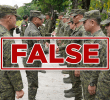Year in Review
DAVAO CITY— The bomb that went off on New Year’s Eve in a crowded public market in M’lang town in North Cotabato marked the last day of the year that turned gruesome and deadly for several areas in Mindanao.
The M’lang bomb explosion claimed the lives of two civilians. Two remained in critical condition while 34 others wounded and now recuperating in hospitals.
Another bomb exploded a month earlier in the town, on November 23, at the town plaza that killed two victims and hurt 25 others.
An explosion also happened last November 16 in Kabacan town in North Cotabato, and snatched the life of a civilian while it injured 16 others.
On November 6, a bomb explosion hit a Rural Transit bus in Barangay Dologon in Maramag town Bukidnon injuring four passengers.
A deadlier explosion happened inside another Rural Transit Bus in the same town on December 9. Eleven died while more than 40 were hurt after the bus picked up passengers along a road fronting the Central Mindanao University (CMU) in Sitio Musuan, Barangay Dologon, Maramag.
Among those killed were CMU students and two farmer activists belonging to the Buffalo-Tamaraw-Limus (BTL) Farmers’ Association who were bound for Cagayan de Oro City to attend a human rights rally.
Other bombing incidents have also occurred in Zambonga, Sulu, General Santos City, Tacurong City, Kidapawan, Koronadal, Sultan Kudarat and Basilan.
Regardless of what group masterminded these ferocious attacks, Mindanao leaders and activists criticized the acts for targeting civilians.
Stop bomb attacks
Alarmed by the spate of bombings across Mindanao, Davao City Mayor Rodrigo Duterte has appealed to stop the bomb attacks.
“Please stop these attacks. You have to consider the lives of civilians,” Duterte said, “I feel for the families of the victims. I am sad.Maawa nalang kayo sa kapwa natin tao (Have mercy on the civilians).”
The bombing incidents have also raised red alerts in all cities in Mindanao, imposing stringent measures to thwart any further attacks.
Davao City Police chief Vicente Danao said “we are not lowering our red alert in the city, in fact we are enhancing police presence and visibility on the streets and areas of convergence. We are imposing stricter checkpoints especially in populated areas like malls and churches to avoid this kind of incident”.
“Everybody should be involved. If there are suspicious passengers, report directly to the authorities to avoid such incident,” said Colonel Macairog Alberto, chief of Task Force Davao.
Three groups named
Taking cue from police and military investigators, President Benigno Aquino III blamed the bombings on three groups: the Abu Sayyaf Group, the Bangsamoro Islamic Fighting Force and the communists New People’s Army.
Aquino declared this to reporters after speaking at the Mindanao Business Conference in Davao City in August.
He said there were the “three threat groups behind the bombings in Mindanao”. He said “it has been working for a long time to neutralize these elements but with quite a few successes”.
In the Bukidnon bomb bus incident, Brig. Gen. Alexander Balutan, deputy commander of the Eastern Mindanao Command said the BIFF is believed to be the group behind the attack.
“Based on the historical, technical signature of the bombing incident, it points that it is the hand work of the BIFF,” said Balutan.
In North Cotabato twin bombings, Col. Dickson Hermoso, spokesperson of the Philippine Army ‘s 6th Infantry Division, said the improvised explosive devices (IEDs) used in Kabacan bombing were the handiwork of BIFF.
Mayor Joselito Piñol has maintained that the December 31 bombing was the handiwork of the BIFF and said investigation showed that the suspects were believed to be its new recruits.
“The five new BIFF recruits are also believed to be members of the extortion group Al Khobar which earlier sent extortion letters to M’lang businessmen,” said Piñol.
A Mindanao-based peace advocate group, InPeace Mindanao, however, challenged the Aquino administration “to conduct a thorough and scientific investigation into these bombings, leaving no stone unturned such that the possible culpability of state security agents is likewise looked into.”
‘Handiwork of military’
But for the BIFF, it never claimed responsibility to all the bombing incidents and blamed them as the “handiwork of the military.”
BIFF’s Abu Misry Mama recalled in 2003 that it was the military who conducted series of bomb attacks to sow terror in Mindanao.
Mama was referring to a supposed Operation Plan Greenbase, an alleged top-secret military operation during the Arroyo administration. the Oplan was blamed as a scheme to sow terror in Mindanao by staging series of bomb attacks in an attempt to draw funds from anti-terrorist organizations and pin the blame on Moro Islamic Liberation Front.
“So before they will point their finger to us, they should check their facts first. It’s easy to pin the blame to BIFF but the public should never forget the history of the past,” said Mama.
The BIFF has emphasized that its military attacks never targeted civilians. “We don’t attack civilians. We only target the military,” stressed Mama.
“The BIFF has no involvement in the series of bombings in North Cotabato and elsewhere in Mindanao,” Mama said.
The BIFF spokesman also welcomed Duterte’s invitation to meet BIFF leaders for a dialogue to discuss issues related to security, peace and order in Mindanao. (davaotoday.com)










